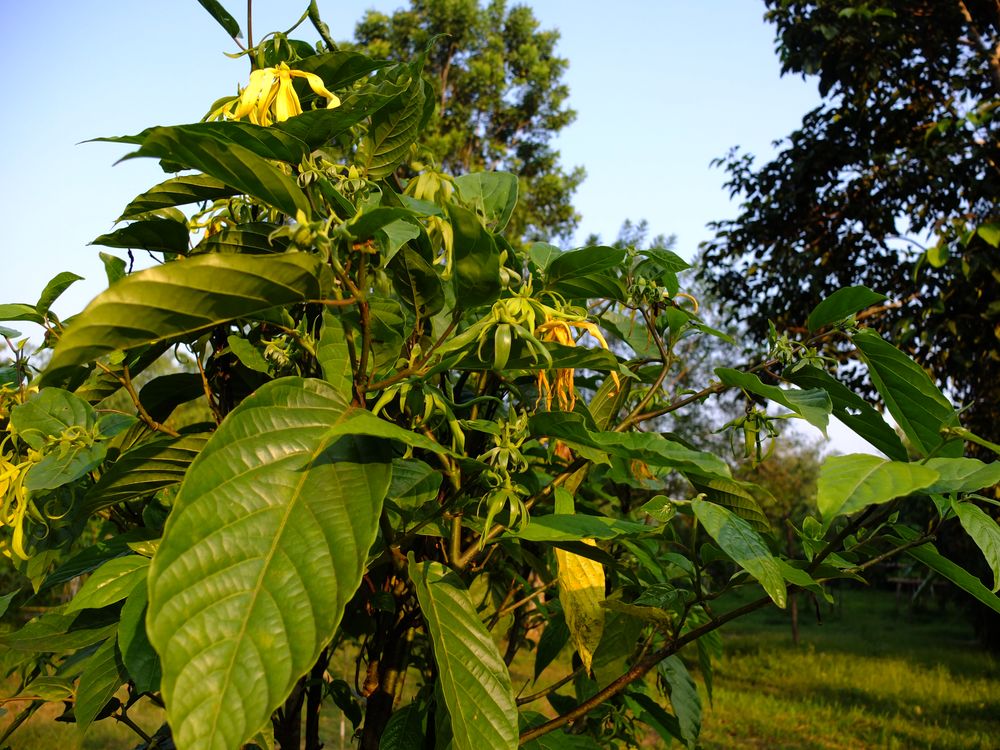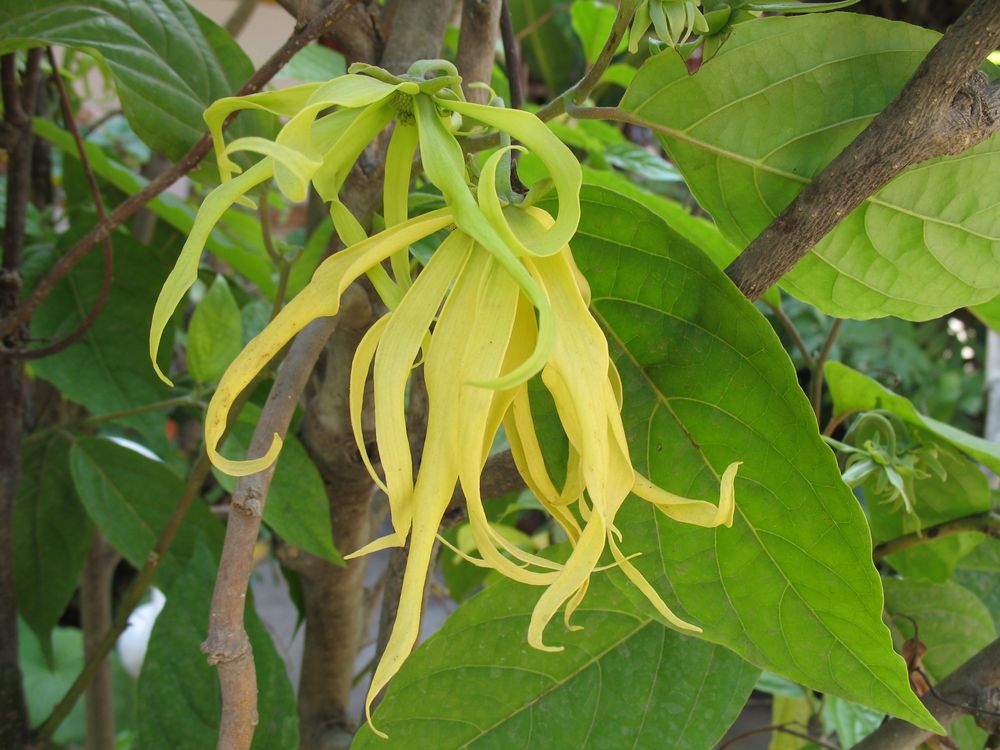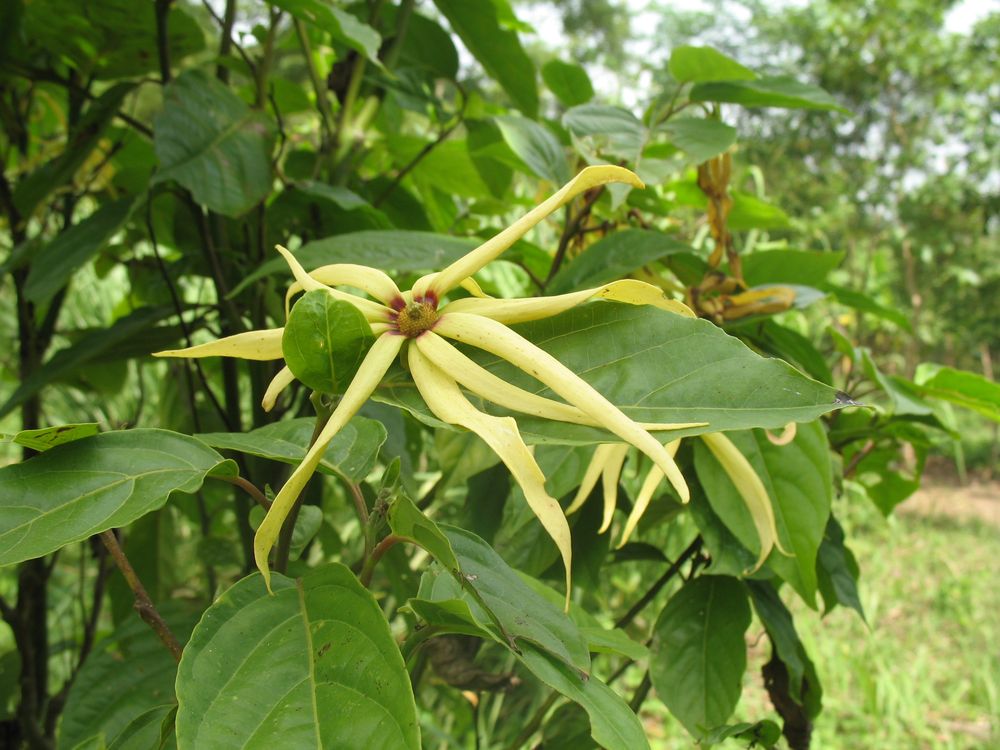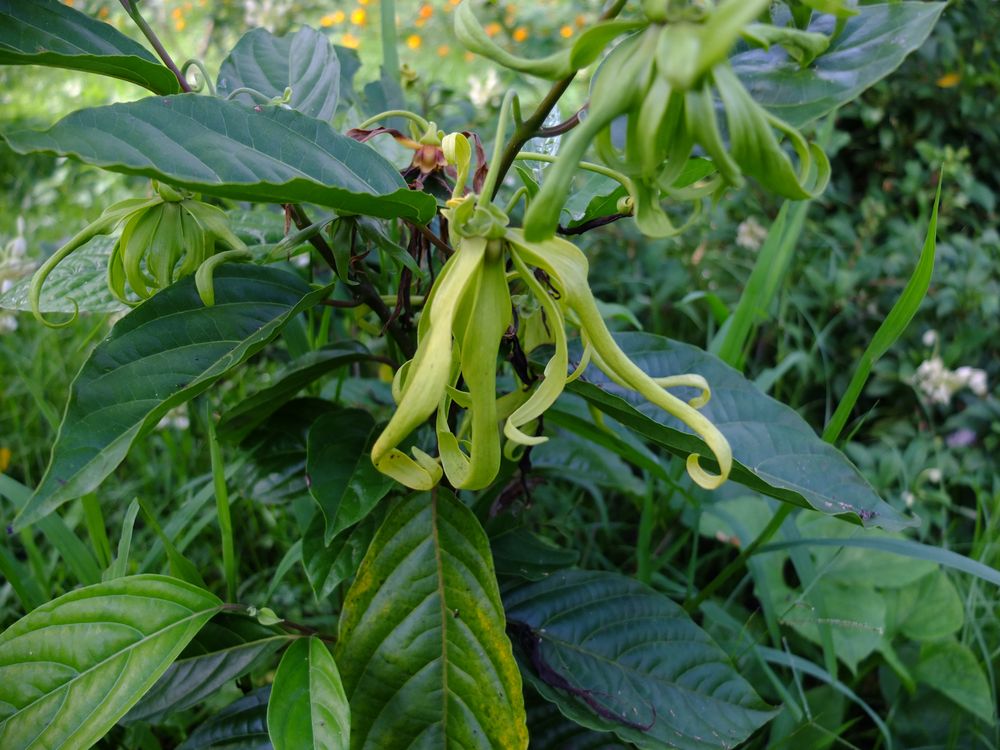This plant native to Malaysia and the Philippines is increasingly seen in gardens in Laos. Its scientific name, which is taken up in Lao and Thai, comes from the language of the Dayaks of Borneo: kenanga. French and English more readily use the term Ylang Ylang which means “the flower of flowers” in Malay.
This medium-sized tree has dark green, simple leaves that alternate along the branchlets. The flowers, with a sweet perfume for some, violent for others, form drooping axillary clusters; they have 3 yellow sepals and 6 petals, lanceolate, twisted when young, smooth when mature. The fruits, the size of olives, whose color they are, are very popular with birds.
Ylang Ylang grows rapidly, more than 2 meters per year, but when it is exploited for its flowers, it is cut regularly at the height of a vine stock so that picking is easier. By distilling the flowers, we obtain an essence used in perfumery which gives many perfumes an elegant and floral note (“Air du Temps” by Nina Ricci, “Poison” by Dior) and which constitutes the basis of many cosmetic preparations.
It is indeed for French perfumers that the cultivation of Ylang Ylang was introduced in 1909 in Madagascar and especially in the Comoros which, with a production of 60 tons per year, is the world’s leading producer, but demand is down due to the use of synthetic fragrances.
In aromatherapy the essence of Ylang Ylang is used to treat stress, insomnia, it would also have aphrodisiac and euphoric properties. All these properties are known from traditional medicines. In Laos it is said that “flowers stop discomfort and make you euphoric”; they also enter into the vegetable bouquet placed in steam baths (ya hom); fresh flowers heated with coconut oil restore strength and suppleness to hair; finally, a leaf and wood decoction is drunk as a diuretic.
We do not know of symbolic uses of the plant, which is surprising for such a fragrant flower, but in the area of influence of Indian culture, where perfumes hold a great ritual place, the introduction of Ylang Ylang is relatively recent and it is not part of the traditional rituals. One can also think that its particular habit is ill-suited to decorative or ritual use, unless, the superstition which prevails among the Thais, proscribing Ylang Ylang from gardens, for its soft and brittle wood, a bad omen, influenced the Lao.
On voit de plus en plus cette plante originaire de Malaisie et des Philippines dans les jardins au Laos. Son nom scientifique qui est repris en lao et en thaï vient de la langue des Dayak de Bornéo: kenanga. Le français et l’anglais emploient plus volontiers le terme ylang ylang qui signifie « la fleur des fleurs » en Malais.
Cet arbre de taille moyenne a des feuilles vert foncé, simples, alternes le long des rameaux. Les fleurs, au parfum suave pour les uns, violent pour les autres, forment des grappes axillaires retombantes ; elles ont 3 sépales et 6 pétales jaunes, lancéolés, torsadés quand ils sont jeunes, lisses à maturité. Les fruits gros comme des olives dont ils ont la couleur, sont très appréciés des oiseaux.
L’ylang ylang pousse rapidement, plus de 2 mètres par an, mais lorsqu’il est exploité pour ses fleurs on le coupe régulièrement à la hauteur d’un pied de vigne pour que la cueillette soit plus facile. Par distillation des fleurs on obtient une essence employée en parfumerie qui donne à de très nombreux parfums une note élégante et florale (« Air du Temps » de Nina Ricci, « Poison » de Dior) et qui constitue la base de nombreuses préparations cosmétiques.
C’est en effet pour les parfumeurs français que la culture de l’ylang ylang a été introduite en 1909 à Madagascar et surtout aux Comores qui, avec une production de 60 tonnes par an, en est le premier producteur mondial, mais la demande est en baisse par suite de l’utilisation de parfums de synthèse.
En aromathérapie l’essence d’ylang ylang est utilisée pour traiter le stress, l’insomnie, elle aurait en outre des propriétés aphrodisiaques et euphorisantes. Toutes ces propriétés sont connues des médecines traditionnelles. Au Laos on dit que «les fleurs arrêtent les malaises et rendent euphorique »; elles entrent aussi dans le bouquet végétal mis dans les bains de vapeur (ya hom); les fleurs fraîches chauffées avec de l’huile de noix de coco rendent force et souplesse aux cheveux; enfin, une décoction de feuilles et de bois est bue comme diurétique.
On ne connaît pas d’usages symboliques de la plante ce qui est étonnant pour une fleur si parfumée, mais dans la zone d’influence de la culture indienne, où les parfums tiennent une grande place rituelle, l’introduction de l’ylang ylang est relativement récente et elle ne fait pas partie des rituels traditionnels. On peut penser aussi que son port particulier est mal adapté à un usage décoratif ou rituel, à moins que, la superstition qui a cours chez les Thaï, proscrivant l’ylang ylang des jardins, pour son bois mou et cassant, de mauvais augure, ait influencé les Lao.




This plant native to Malaysia and the Philippines is increasingly seen in gardens in Laos. Its scientific name, which is taken up in Lao and Thai, comes from the language of the Dayaks of Borneo: kenanga. French and English more readily use the term Ylang Ylang which means “the flower of flowers” in Malay.
This medium-sized tree has dark green, simple leaves that alternate along the branchlets. The flowers, with a sweet perfume for some, violent for others, form drooping axillary clusters; they have 3 yellow sepals and 6 petals, lanceolate, twisted when young, smooth when mature. The fruits, the size of olives, whose color they are, are very popular with birds.
Ylang Ylang grows rapidly, more than 2 meters per year, but when it is exploited for its flowers, it is cut regularly at the height of a vine stock so that picking is easier. By distilling the flowers, we obtain an essence used in perfumery which gives many perfumes an elegant and floral note (“Air du Temps” by Nina Ricci, “Poison” by Dior) and which constitutes the basis of many cosmetic preparations.
It is indeed for French perfumers that the cultivation of Ylang Ylang was introduced in 1909 in Madagascar and especially in the Comoros which, with a production of 60 tons per year, is the world’s leading producer, but demand is down due to the use of synthetic fragrances.
In aromatherapy the essence of Ylang Ylang is used to treat stress, insomnia, it would also have aphrodisiac and euphoric properties. All these properties are known from traditional medicines. In Laos it is said that “flowers stop discomfort and make you euphoric”; they also enter into the vegetable bouquet placed in steam baths (ya hom); fresh flowers heated with coconut oil restore strength and suppleness to hair; finally, a leaf and wood decoction is drunk as a diuretic.
We do not know of symbolic uses of the plant, which is surprising for such a fragrant flower, but in the area of influence of Indian culture, where perfumes hold a great ritual place, the introduction of Ylang Ylang is relatively recent and it is not part of the traditional rituals. One can also think that its particular habit is ill-suited to decorative or ritual use, unless, the superstition which prevails among the Thais, proscribing Ylang Ylang from gardens, for its soft and brittle wood, a bad omen, influenced the Lao.
On voit de plus en plus cette plante originaire de Malaisie et des Philippines dans les jardins au Laos. Son nom scientifique qui est repris en lao et en thaï vient de la langue des Dayak de Bornéo: kenanga. Le français et l’anglais emploient plus volontiers le terme ylang ylang qui signifie « la fleur des fleurs » en Malais.
Cet arbre de taille moyenne a des feuilles vert foncé, simples, alternes le long des rameaux. Les fleurs, au parfum suave pour les uns, violent pour les autres, forment des grappes axillaires retombantes ; elles ont 3 sépales et 6 pétales jaunes, lancéolés, torsadés quand ils sont jeunes, lisses à maturité. Les fruits gros comme des olives dont ils ont la couleur, sont très appréciés des oiseaux.
L’ylang ylang pousse rapidement, plus de 2 mètres par an, mais lorsqu’il est exploité pour ses fleurs on le coupe régulièrement à la hauteur d’un pied de vigne pour que la cueillette soit plus facile. Par distillation des fleurs on obtient une essence employée en parfumerie qui donne à de très nombreux parfums une note élégante et florale (« Air du Temps » de Nina Ricci, « Poison » de Dior) et qui constitue la base de nombreuses préparations cosmétiques.
C’est en effet pour les parfumeurs français que la culture de l’ylang ylang a été introduite en 1909 à Madagascar et surtout aux Comores qui, avec une production de 60 tonnes par an, en est le premier producteur mondial, mais la demande est en baisse par suite de l’utilisation de parfums de synthèse.
En aromathérapie l’essence d’ylang ylang est utilisée pour traiter le stress, l’insomnie, elle aurait en outre des propriétés aphrodisiaques et euphorisantes. Toutes ces propriétés sont connues des médecines traditionnelles. Au Laos on dit que «les fleurs arrêtent les malaises et rendent euphorique »; elles entrent aussi dans le bouquet végétal mis dans les bains de vapeur (ya hom); les fleurs fraîches chauffées avec de l’huile de noix de coco rendent force et souplesse aux cheveux; enfin, une décoction de feuilles et de bois est bue comme diurétique.
On ne connaît pas d’usages symboliques de la plante ce qui est étonnant pour une fleur si parfumée, mais dans la zone d’influence de la culture indienne, où les parfums tiennent une grande place rituelle, l’introduction de l’ylang ylang est relativement récente et elle ne fait pas partie des rituels traditionnels. On peut penser aussi que son port particulier est mal adapté à un usage décoratif ou rituel, à moins que, la superstition qui a cours chez les Thaï, proscrivant l’ylang ylang des jardins, pour son bois mou et cassant, de mauvais augure, ait influencé les Lao.








This plant native to Malaysia and the Philippines is increasingly seen in gardens in Laos. Its scientific name, which is taken up in Lao and Thai, comes from the language of the Dayaks of Borneo: kenanga. French and English more readily use the term Ylang Ylang which means “the flower of flowers” in Malay.
This medium-sized tree has dark green, simple leaves that alternate along the branchlets. The flowers, with a sweet perfume for some, violent for others, form drooping axillary clusters; they have 3 yellow sepals and 6 petals, lanceolate, twisted when young, smooth when mature. The fruits, the size of olives, whose color they are, are very popular with birds.
Ylang Ylang grows rapidly, more than 2 meters per year, but when it is exploited for its flowers, it is cut regularly at the height of a vine stock so that picking is easier. By distilling the flowers, we obtain an essence used in perfumery which gives many perfumes an elegant and floral note (“Air du Temps” by Nina Ricci, “Poison” by Dior) and which constitutes the basis of many cosmetic preparations.
It is indeed for French perfumers that the cultivation of Ylang Ylang was introduced in 1909 in Madagascar and especially in the Comoros which, with a production of 60 tons per year, is the world’s leading producer, but demand is down due to the use of synthetic fragrances.
In aromatherapy the essence of Ylang Ylang is used to treat stress, insomnia, it would also have aphrodisiac and euphoric properties. All these properties are known from traditional medicines. In Laos it is said that “flowers stop discomfort and make you euphoric”; they also enter into the vegetable bouquet placed in steam baths (ya hom); fresh flowers heated with coconut oil restore strength and suppleness to hair; finally, a leaf and wood decoction is drunk as a diuretic.
We do not know of symbolic uses of the plant, which is surprising for such a fragrant flower, but in the area of influence of Indian culture, where perfumes hold a great ritual place, the introduction of Ylang Ylang is relatively recent and it is not part of the traditional rituals. One can also think that its particular habit is ill-suited to decorative or ritual use, unless, the superstition which prevails among the Thais, proscribing Ylang Ylang from gardens, for its soft and brittle wood, a bad omen, influenced the Lao.
On voit de plus en plus cette plante originaire de Malaisie et des Philippines dans les jardins au Laos. Son nom scientifique qui est repris en lao et en thaï vient de la langue des Dayak de Bornéo: kenanga. Le français et l’anglais emploient plus volontiers le terme ylang ylang qui signifie « la fleur des fleurs » en Malais.
Cet arbre de taille moyenne a des feuilles vert foncé, simples, alternes le long des rameaux. Les fleurs, au parfum suave pour les uns, violent pour les autres, forment des grappes axillaires retombantes ; elles ont 3 sépales et 6 pétales jaunes, lancéolés, torsadés quand ils sont jeunes, lisses à maturité. Les fruits gros comme des olives dont ils ont la couleur, sont très appréciés des oiseaux.
L’ylang ylang pousse rapidement, plus de 2 mètres par an, mais lorsqu’il est exploité pour ses fleurs on le coupe régulièrement à la hauteur d’un pied de vigne pour que la cueillette soit plus facile. Par distillation des fleurs on obtient une essence employée en parfumerie qui donne à de très nombreux parfums une note élégante et florale (« Air du Temps » de Nina Ricci, « Poison » de Dior) et qui constitue la base de nombreuses préparations cosmétiques.
C’est en effet pour les parfumeurs français que la culture de l’ylang ylang a été introduite en 1909 à Madagascar et surtout aux Comores qui, avec une production de 60 tonnes par an, en est le premier producteur mondial, mais la demande est en baisse par suite de l’utilisation de parfums de synthèse.
En aromathérapie l’essence d’ylang ylang est utilisée pour traiter le stress, l’insomnie, elle aurait en outre des propriétés aphrodisiaques et euphorisantes. Toutes ces propriétés sont connues des médecines traditionnelles. Au Laos on dit que «les fleurs arrêtent les malaises et rendent euphorique »; elles entrent aussi dans le bouquet végétal mis dans les bains de vapeur (ya hom); les fleurs fraîches chauffées avec de l’huile de noix de coco rendent force et souplesse aux cheveux; enfin, une décoction de feuilles et de bois est bue comme diurétique.
On ne connaît pas d’usages symboliques de la plante ce qui est étonnant pour une fleur si parfumée, mais dans la zone d’influence de la culture indienne, où les parfums tiennent une grande place rituelle, l’introduction de l’ylang ylang est relativement récente et elle ne fait pas partie des rituels traditionnels. On peut penser aussi que son port particulier est mal adapté à un usage décoratif ou rituel, à moins que, la superstition qui a cours chez les Thaï, proscrivant l’ylang ylang des jardins, pour son bois mou et cassant, de mauvais augure, ait influencé les Lao.


